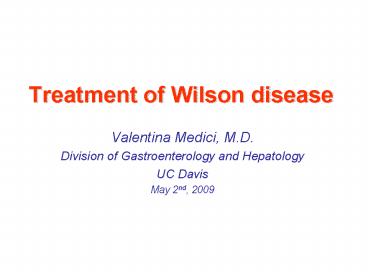Treatment of Wilson disease - PowerPoint PPT Presentation
1 / 22
Title:
Treatment of Wilson disease
Description:
Copper chelator: Cu urinary excretion. Dose: 750-1500 mg/daily pyridoxine (B6) daily ... Cholic acid, radiation, partial hepatectomy. Conclusions ... – PowerPoint PPT presentation
Number of Views:1860
Avg rating:5.0/5.0
Title: Treatment of Wilson disease
1
Treatment of Wilson disease
- Valentina Medici, M.D.
- Division of Gastroenterology and Hepatology
- UC Davis
- May 2nd, 2009
2
Outline
- Treatment options
- Mechanism of action
- Side effects
- Strategies for better management
- New prospectives
3
Options
- Chelating agents (Penicillamine, Trientine)
- Zinc
- Tetrathiomolybdate (?)
- Diet
- Liver Transplantation
4
Copper
intestine
Albumin
Ceruloplasmin
ATP7B
Blood
5
Chelating agents Penicillamine and Trientine
Copper
intestine
Penicillamine/Trientine
Ceruloplasmin
urine
6
Penicillamine
- Copper chelator ? Cu urinary excretion
- Dose 750-1500 mg/daily pyridoxine (B6) daily
- 30 discontinued for side effects
- Can worsen neurological symptoms (up to 50)
- Rare birth defects (cutis laxa)
7
Penicillamine side effects
- Fever, rash, lymphoadenopathy
- Aplastic anemia, neutropenia and thrombocytopenia
- Late side effects elastosis perforans
serpiginosa, arthropathy, lupus-like reaction,
nephrotic syndrome, myastenia gravis, Goodpasture
syndrome
Scheinberg IH, Sternlieb I. Wilsons disease.
In Smith LH Jr., Ed. Philadelphia W.B.
Saunders, 231984
8
Trientine
- Cu chelator
- New first choice
- Fewer side effects than penicillamine
- More tolerable for neurological symptoms
- Dose 750 -1500 mg/daily
- Side effects? rare pancytopenia
9
Zinc Acetate/Sulfate
Copper
Zinc
intestine
metallothionein
Albumin
Ceruloplasmin
10
Zinc Sulfate/Acetate
- Blocks Cu absorption
- Prevents Cu toxicity
- ? Cu Urinary Excretion
- Minor side effects (dyspepsia)
- Acetate is better tolerated
- Dose 150 mg daily of elemental zinc
- Slow action (4-6 months)
- No concerns during pregnancy, safe for
neurological symptoms
Brewer GJ, J Lab Clin Med, 1999
11
Combination therapy
- Penicillamine Zinc ? dubious efficacy
- Trientine Zinc ? yes for decompensated cirrhosis
Brewer, JAmCollNutr, 1993
Askari, JLabClinMed, 2003
12
Tetrathiomolybdate
- Forms a complex with copper and protein
- Taken with meals? complexes Cu in the food and is
secreted into the intestine between meals? it is
absorbed and complexes Cu in the blood with
albumin - More efficacy for neurological symptoms
- Not yet approved
13
Tetrathiomolybdate (TM) for neurological symptoms
- 23 pts on Trientine
- 25 pts on TM
- 8 weeks
- Trientine?26 risk of neuro deterioration
- TM ?4 risk of neuro deterioration
Brewer GJ, Arch Neurol, 2006
14
33 yo, man, with severe neurological WD
stop TTM
TTM 180 mg/day
TTM 120 mg/day
Medici V, Mov Disord, 2006
15
Indications
16
Management during follow up
- Depends on the severity of the neurological or
hepatic features - Assess any sign of hepatic decompensation
- 24-h urinary Cu excretion (denotes adequate
treatment) - Monitor penicillamine side effects
17
Management of hepatic WD
- About 30 of patients have mildly increased
transaminase level? benign - Liver biopsy
- Try an alternative anti-copper agent
- Add Vitamin E (antioxidant effect)
Iorio, J Pediatr Gastroenterol Nutr, 2004
von Herbay A, J Hepatol, 1994
18
Compliance
- Sudden interruption of therapy in Wilson disease
can result in Acute Liver Failure
Walshe, Lancet, 1986
19
LEC rats
- Gene therapy
- Lentiviral gene transfer (ATP7B)
- Increased levels of ceruloplasmin
- Reduced hepatic copper
- Improved hepatic fibrosis
Merle, Scand J Gastro, 2006
20
Bone marrow stem cells
TOXIC MILK MOUSE (N 46)
Transplant with bone marrow stem cells
N11 (24) liver ripopulation Reduction of
hepatic copper accumulation
Sublethal radiation
Allen KJ, Cell Transplant, 2004
21
Hepatocytes transplantation
Cholic acid, radiation, partial hepatectomy
Spleen
LEC rats
Liver
Hepatocytes
- 6 months after transplant liver was extensively
repopulated with hepatocytes - ATP7B expression, increased Cp, reduced hepatic
Cu - Improved liver histology
Joseph, Gastro, 2009
22
Conclusions
- WD is a very peculiar medical situation? genetic
but treatable disorder, almost complete
resolution of symptoms with appropriate and
timely therapy - Early diagnosis and early therapy are mandatory
- Compliance to medical treatment is crucial































